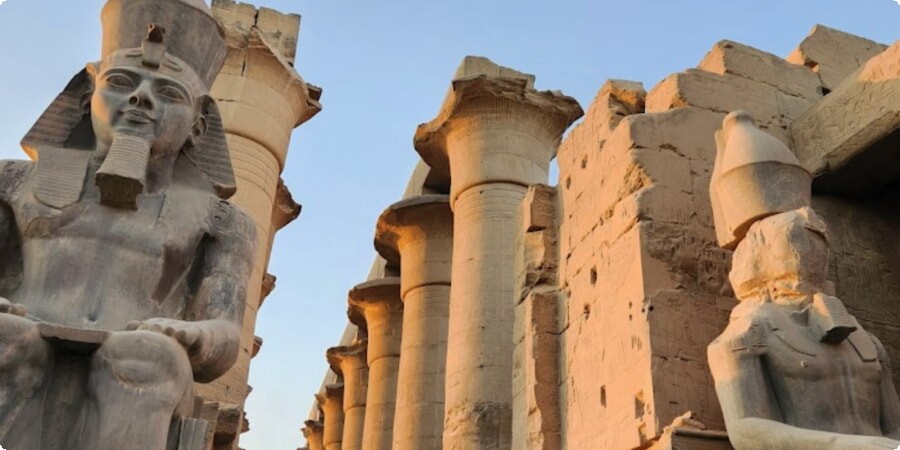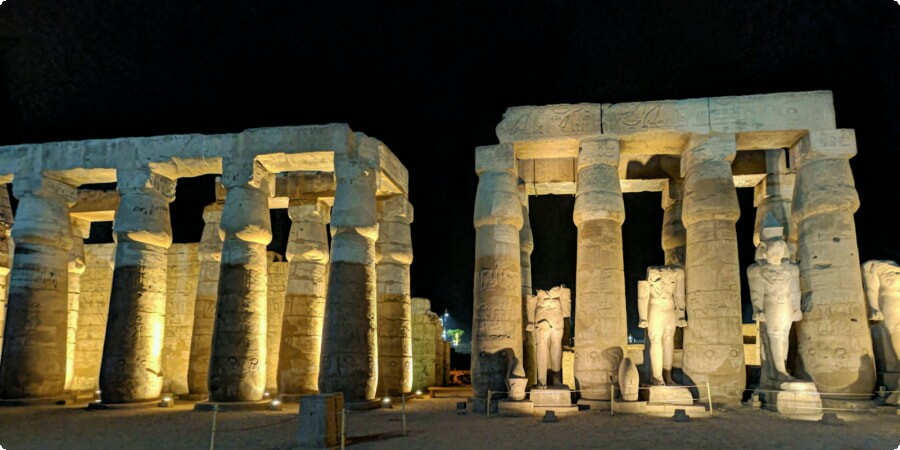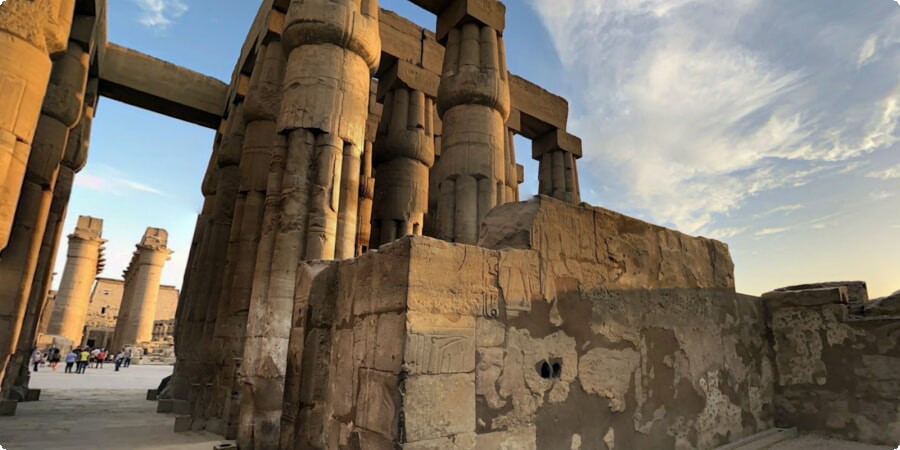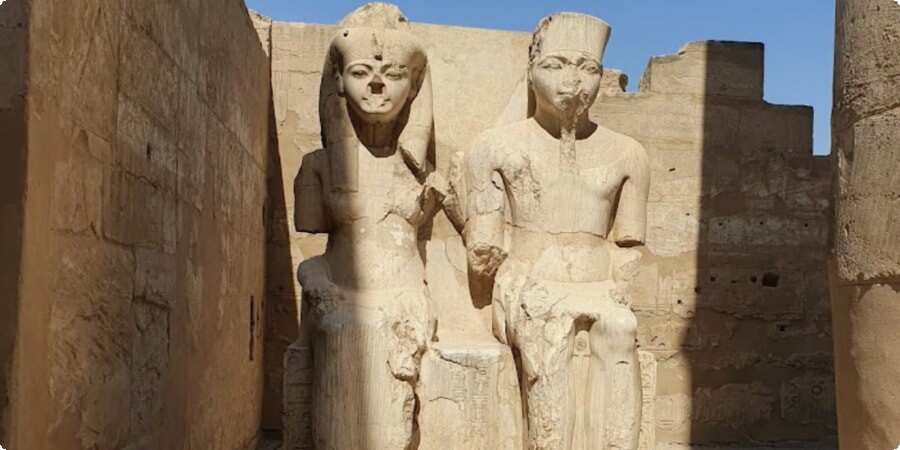Luxor Temple stands as a remarkable testament to the splendor of ancient Egypt, located on the east bank of the Nile River in the modern city of Luxor. This temple, originally known as "Ipet-resyt" or the "Southern Sanctuary," was a focal point of the ancient city of Thebes, a major center of power, culture, and religion. Unlike many other temples dedicated to gods, Luxor Temple was primarily dedicated to the rejuvenation of kingship and was the site where many pharaohs were crowned. Today, it remains one of Egypt's most visited and revered sites, inviting visitors to step into a world where history and myth converge.
Historical Background
The construction of Luxor Temple began during the reign of Amenhotep III in the 14th century BCE and was completed by subsequent pharaohs, including Tutankhamun and Ramses II. The temple was built on the site of an earlier sanctuary, reflecting the long-standing religious significance of this location.
Amenhotep III, known for his grand architectural projects, initiated the construction of the temple, focusing on its inner sanctuaries and courtyards. The design was intended to celebrate the divine nature of the pharaoh's rule and his relationship with the gods, particularly Amun, Mut, and Khonsu, who constituted the Theban Triad.
During the 19th Dynasty, Ramses II expanded Luxor Temple significantly. He added a grand pylon, two towering obelisks (one of which now stands in Paris at the Place de la Concorde), and numerous colossal statues of himself. This expansion not only enhanced the temple's grandeur but also solidified Ramses II's legacy as one of Egypt's most powerful rulers.
The temple's history continued into the Greco-Roman period, with additions and modifications reflecting the evolving religious landscape. Alexander the Great, for instance, constructed a shrine within the temple, integrating elements of Greek worship.
Architectural Features
Luxor Temple is an architectural masterpiece, showcasing the ingenuity and artistry of ancient Egyptian builders. The temple complex is a blend of majestic columns, grand courtyards, and intricately decorated sanctuaries, each telling a story of divine kingship and religious devotion.
The Colonnade of Amenhotep III: One of the most striking features of Luxor Temple is the colonnade built by Amenhotep III. This grand hall, lined with 14 towering columns, creates a dramatic entrance leading from the open-air court to the more intimate sanctuaries. The walls of the colonnade are adorned with detailed reliefs depicting the Opet Festival, an annual event celebrating the rejuvenation of the pharaoh's power.
The Great Court of Ramses II: Entering the temple through the grand pylon, visitors arrive at the Great Court, constructed by Ramses II. This open courtyard is surrounded by double rows of papyrus-bundle columns, creating a sense of grandeur and openness. The court is filled with statues and inscriptions celebrating Ramses II's military victories and divine status.

Sanctuaries and Inner Chambers: The innermost part of the temple houses the sanctuaries dedicated to the Theban Triad. These spaces were the focus of the most sacred rituals, where statues of the gods were bathed, dressed, and presented with offerings. The walls here are adorned with scenes depicting pharaohs interacting with the gods, highlighting the divine nature of kingship.
Obelisks and Statues: Luxor Temple was originally adorned with two massive obelisks at its entrance, symbolizing the sun god Ra. Today, only one remains in its original location, while the other stands in Paris. The temple complex also features numerous colossal statues of pharaohs, particularly Ramses II, each a testament to the ruler's divine authority and architectural ambition.
For visitors planning to explore Luxor Temple and other ancient sites in Egypt, renting a car provides the flexibility and convenience to travel at your own pace. Start your journey with a rental car from Cairo Airport for a seamless travel experience. Book your car rental in Cairo Airport here.
Learn more about Luxor Temple on Wikipedia
Explore the location of Luxor Temple on Google Maps
Religious and Cultural Significance
Luxor Temple was not just a magnificent architectural achievement but also a vital religious and cultural center in ancient Egypt. Unlike many other temples, which were primarily dedicated to the gods, Luxor Temple was dedicated to the rejuvenation of kingship. It played a crucial role in the celebration of the Opet Festival, one of the most significant religious events in the ancient Egyptian calendar.
The Opet Festival was an annual event that celebrated the divine birth and renewal of the pharaoh's power. During this festival, statues of the gods Amun, Mut, and Khonsu were transported in a grand procession from Karnak Temple to Luxor Temple. This journey symbolized the joining of the gods with the pharaoh, reaffirming his divine right to rule. The festival included elaborate rituals, offerings, and ceremonies that reinforced the pharaoh's sacred bond with the deities and the renewal of his kingship.
Luxor Temple also served as a center for the cult of the Theban Triad. The sanctuaries within the temple were the focus of daily rituals and offerings, conducted by priests who played a key role in maintaining the divine order. The temple's artwork and inscriptions vividly depict these religious practices, offering valuable insights into the spiritual life of ancient Thebes.

Rediscovery and Excavation
The story of Luxor Temple's rediscovery is as fascinating as its ancient origins. After the decline of ancient Egyptian civilization, the temple gradually fell into disuse and was buried under layers of sand and debris. For centuries, it remained hidden, with only parts of its grand structures visible above the surface.
In the 19th century, European explorers and Egyptologists began to uncover the temple's hidden treasures. Early pioneers like Jean-François Champollion, who deciphered the Rosetta Stone, and Gaston Maspero, a prominent French Egyptologist, played significant roles in documenting and excavating Luxor Temple. Their efforts brought the temple back into the spotlight, revealing its historical and cultural significance to the world.
Throughout the 20th century, extensive archaeological excavations continued to unveil the temple's many secrets. These efforts uncovered numerous statues, inscriptions, and architectural elements that provided invaluable insights into the life and beliefs of ancient Egyptians. The rediscovery of Luxor Temple has greatly enriched our understanding of ancient Egyptian civilization and its enduring legacy.
Preservation efforts have also been crucial in maintaining the integrity of Luxor Temple. Conservation projects aim to stabilize structures, protect delicate carvings, and manage the impact of tourism. These efforts ensure that future generations can continue to marvel at the temple's grandeur and learn from its history.
Visiting Luxor Temple Today
Visiting Luxor Temple today is an unforgettable experience that offers a glimpse into the grandeur and mystique of ancient Egypt. As you walk through the temple's grand courtyards, towering columns, and intricately decorated sanctuaries, you are transported back in time to a world of pharaohs, gods, and ancient rituals.
Practical information for visitors includes the best times to visit, ticket prices, and what to expect during your visit. The temple is open to visitors year-round, with extended hours during the cooler months. Early mornings and late afternoons are the best times to visit, as the temperatures are more comfortable and the lighting is perfect for photography.
A visit to Luxor Temple can be easily combined with other nearby attractions, such as Karnak Temple and the Valley of the Kings. Renting a car is highly recommended for those who wish to explore the region at their own pace. This allows you to experience the full range of historical and cultural sites that Luxor has to offer.

For convenience and flexibility, you can book a rental car in Egypt to make your travels easier and more enjoyable. Book your car rental in Egypt here to ensure a seamless and comfortable journey.
Luxor Temple, with its rich history, stunning architecture, and profound religious significance, remains a must-visit destination for anyone interested in the wonders of ancient Egypt. Its rediscovery and ongoing preservation efforts continue to captivate and educate visitors from around the world, making it a timeless symbol of Egypt's glorious past.
Legacy and Influence
The legacy of Luxor Temple extends far beyond its physical remains, playing a crucial role in our understanding of ancient Egyptian civilization. As a testament to the architectural, religious, and cultural achievements of the New Kingdom, the temple has significantly influenced both historical scholarship and modern cultural perceptions of ancient Egypt.
Luxor Temple's architectural grandeur and artistic achievements have inspired countless studies and explorations. Scholars have meticulously documented its hieroglyphs, reliefs, and structures, providing invaluable insights into the religious practices, political history, and daily life of ancient Egyptians. The temple's detailed carvings and inscriptions are key sources for understanding the dynastic history of the New Kingdom, particularly the reigns of Amenhotep III and Ramses II.
Moreover, the temple's influence can be seen in various cultural works, from literature and film to modern art and architecture. Its majestic columns and grandiose design have become symbols of ancient Egypt's power and sophistication, often depicted in popular media. Luxor Temple's enduring legacy continues to captivate the imagination of people worldwide, making it a symbol of Egypt's rich cultural heritage.
Today, Luxor Temple is not only a historical monument but also a vibrant part of modern Egypt. It plays a significant role in the country's tourism industry, attracting millions of visitors each year who come to marvel at its beauty and learn about its history. Efforts to preserve and promote the temple ensure that it remains a vital link between Egypt's past and present.

Visitor Experience
A visit to Luxor Temple offers a deeply immersive experience, allowing travelers to step into the shoes of ancient worshippers and royalty. As you approach the temple, the imposing first pylon, adorned with carvings of Ramses II's military victories, sets the stage for the grandeur that lies within.
Start your exploration at the Great Court of Ramses II, where colossal statues of the pharaoh greet you. The open courtyard, surrounded by massive columns, provides a sense of the temple's vast scale. From here, proceed to the Colonnade of Amenhotep III, a stunning hall with 14 towering columns, each intricately decorated with scenes from the Opet Festival.
The inner sanctuaries are the heart of Luxor Temple. Here, you'll find the shrine of Amun-Ra, the main deity worshipped at the temple, along with smaller sanctuaries dedicated to Mut and Khonsu. The walls of these chambers are adorned with detailed reliefs depicting the gods and pharaohs, offering a glimpse into the sacred rituals that once took place here.
For a unique experience, consider visiting Luxor Temple at night. The temple is beautifully illuminated, creating a magical atmosphere that enhances the grandeur of its architecture. The evening Sound and Light Show brings the history of Luxor Temple to life with dramatic narrations and visual effects, making it a memorable highlight of any visit.
To make the most of your visit, hiring a knowledgeable guide can provide deeper insights into the temple's history and significance. Additionally, for those exploring multiple sites in the region, renting a car offers flexibility and convenience. Book your car rental in Egypt here to ensure a smooth and comfortable travel experience.
Luxor Temple stands as a timeless symbol of the grandeur and mystique of ancient Egypt. Its architectural brilliance, rich history, and profound religious significance make it an essential destination for anyone interested in exploring the wonders of the past. From its origins under Amenhotep III to the expansions by Ramses II and beyond, Luxor Temple offers a fascinating journey through time.
The temple's rediscovery and excavation have provided invaluable insights into ancient Egyptian civilization, while ongoing preservation efforts ensure that this historical treasure continues to inspire and educate future generations. As you walk through its grand courtyards, marvel at its towering columns, and reflect on its sacred sanctuaries, Luxor Temple invites you to connect with a world that shaped the course of history.
Whether you're a history enthusiast, a curious traveler, or someone seeking a deeper understanding of ancient cultures, Luxor Temple promises an unforgettable experience. Its legacy, influence, and enduring beauty make it a must-visit landmark, offering a unique window into the heart of ancient Thebes.